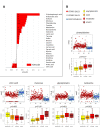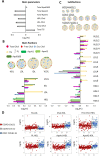Profiling metabolites and lipoproteins in COMETA, an Italian cohort of COVID-19 patients
- PMID: 35446921
- PMCID: PMC9022834
- DOI: 10.1371/journal.ppat.1010443
Profiling metabolites and lipoproteins in COMETA, an Italian cohort of COVID-19 patients
Abstract
Metabolomics and lipidomics have been used in several studies to define the biochemical alterations induced by COVID-19 in comparison with healthy controls. Those studies highlighted the presence of a strong signature, attributable to both metabolites and lipoproteins/lipids. Here, 1H NMR spectra were acquired on EDTA-plasma from three groups of subjects: i) hospitalized COVID-19 positive patients (≤21 days from the first positive nasopharyngeal swab); ii) hospitalized COVID-19 positive patients (>21 days from the first positive nasopharyngeal swab); iii) subjects after 2-6 months from SARS-CoV-2 eradication. A Random Forest model built using the EDTA-plasma spectra of COVID-19 patients ≤21 days and Post COVID-19 subjects, provided a high discrimination accuracy (93.6%), indicating both the presence of a strong fingerprint of the acute infection and the substantial metabolic healing of Post COVID-19 subjects. The differences originate from significant alterations in the concentrations of 16 metabolites and 74 lipoprotein components. The model was then used to predict the spectra of COVID-19>21 days subjects. In this group, the metabolite levels are closer to those of the Post COVID-19 subjects than to those of the COVID-19≤21 days; the opposite occurs for the lipoproteins. Within the acute phase patients, characteristic trends in metabolite levels are observed as a function of the disease severity. The metabolites found altered in COVID-19≤21 days patients with respect to Post COVID-19 individuals overlap with acute infection biomarkers identified previously in comparison with healthy subjects. Along the trajectory towards healing, the metabolome reverts back to the "healthy" state faster than the lipoproteome.
Conflict of interest statement
The authors have declared that no competing interests exist.
Figures




References
Publication types
MeSH terms
Substances
LinkOut - more resources
Full Text Sources
Medical
Miscellaneous

